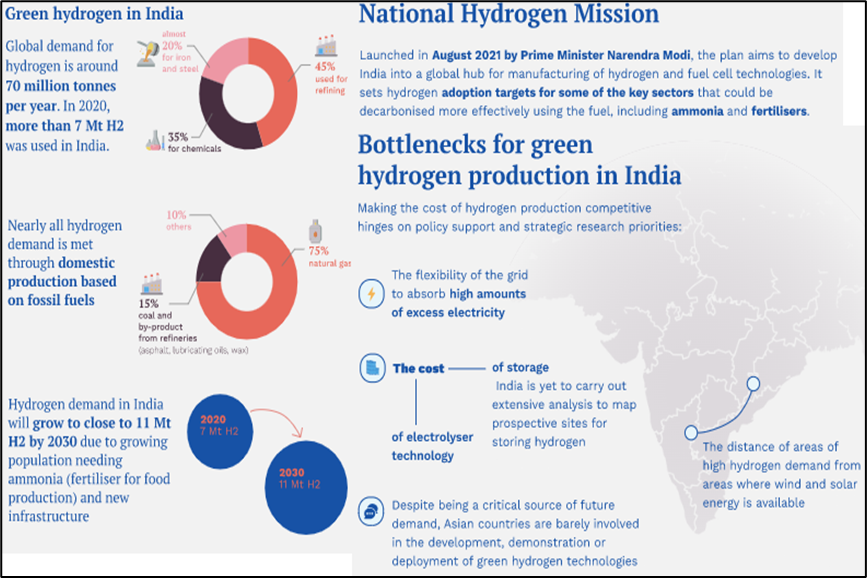Why in News?
- In a bid to cut emissions and become a major export player in the field, India is planning a ₹180-billion ($2.2 billion) incentive programme for the green hydrogen industry.
What’s in today’s article:
- What is green hydrogen?
- Applications of green hydrogen
- India in green hydrogen race
- News Summary
What is green hydrogen?

- Hydrogen gas can be used as a fuel and it does not release greenhouse gas (GHG) emissions such as carbon dioxide when it is burned. Hence, a potential clean alternative to fossil fuels.
- Hydrogen is the most abundant chemical element in the universe, however, it does not naturally exist as a gas in usable quantities, occurring almost entirely in compounds, such as water.
- Therefore, hydrogen must be produced using industrial methods like reforming natural gas (a fossil fuel), electrolysis (in an electrolyser) - an electric current is used to split water into its basic components: hydrogen and oxygen.
- In a fuel cell (device that converts the energy of a chemical into electricity), hydrogen gas reacts with oxygen to produce electricity and water vapour.
- Green hydrogen is the name given to hydrogen gas that has been produced using renewable energy, such as wind or solar power, which create no GHG emissions.
- Comparing with grey and blue hydrogen:
- While hydrogen gas does not emit GHGs when burned, the electricity used to produce it, may have been generated by fossil fuels. This is commonly known as ‘grey hydrogen’, which currently accounts for 95% of the total production.
- Hydrogen produced using electricity generated by burning fossil fuels, but paired with carbon capture and storage (CCS) technologies, which prevent GHGs from entering the atmosphere, is labelled ‘blue’.
Applications of green hydrogen:
- Globally, most of the hydrogen produced today is used in the refining and industrial sectors - to make ammonia for the fertiliser industry, has applications in the steel industry.
- In developing countries such as India, which is investing in the National Hydrogen Mission, hydrogen could be used in transportation, power generation and industry.
- By the end of the decade, the International Energy Agency (IEA) anticipates that hydrogen will find a host of new applications, including powering grids and fuelling the building and transportation sectors.
India in green hydrogen race:

News Summary:
- Current scenario in India:
- Indian oil refineries and fertiliser and steel plants annually use 5 million tonnes of hydrogen made from natural gas, called grey hydrogen.
- Higher gas prices have pushed the Indian grey hydrogen price to about ₹200 per kg from ₹130 a year ago.
- Recently, the U.S.-based Ohmium International commissioned India's first green-hydrogen factory in Bengaluru.
- Proposal:
- The green hydrogen proposal is likely to be called "Strategic Intervention for Green Hydrogen Transition (SIGHT)."
- It will be split into ₹45 billion for electrolyser manufacturing for five years and ₹135 billion for green hydrogen and green ammonia production for three years. The incentive for making green hydrogen is likely to be ₹50 per kg for three years.
- India aims to sell 70% of the production to countries such as South Korea, Japan and in the European Union, and derivatives, including green ammonia, had an equally strong demand.
- The Indian aid could be announced in the February 1 Budget for the fiscal year beginning April 1.
- Significance of the incentive: It aims to reduce the production cost (from current ₹300 - ₹400 per kg) of green hydrogen by a fifth over the next five years, by increasing the scale of the industry.
- Announcements and expectations:
- Earlier, the government announced plans for India to make 5 million tonnes of green hydrogen annually by 2030, a figure that could be doubled, depending on international demand - estimated to exceed 100 million tonnes by 2030, from just under 75 million tonnes now.
- The government also plans for the country to achieve electrolyser manufacturing capacity of 15 gigawatts in phases by 2030. That would be almost 10 times the current global capacity.
- The Indian government expects industry to invest ₹8 trillion in green hydrogen and its derivative green ammonia by 2030. Adani had said recently that along with France's TotalEnergies, it would create the "world's largest green hydrogen ecosystem".









